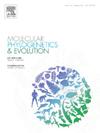Convergent evolution in nuclear and mitochondrial OXPHOS subunits underlies the phylogenetic discordance in deep lineages of Squamata
IF 3.6
1区 生物学
Q2 BIOCHEMISTRY & MOLECULAR BIOLOGY
引用次数: 0
Abstract
The order Squamata is a good candidate for detecting unusual patterns of mitochondrial evolution. The lineages leading to the snake and agamid clades likely experienced convergent evolution in mitochondrial OXidative PHOSphorylation (OXPHOS) genes, which provides strong support for the sister relationship of these two groups.
The OXPHOS subunits are encoded by both the nuclear and mitochondrial genomes, which are subject to distinct evolutionary pressures. Nevertheless, the cooperation between OXPHOS subunits is essential for proper OXPHOS function, as incompatibilities between subunits can be highly deleterious.
In the present study, we annotated OXPHOS genes of 56 Squamata species. The nuclear OXPHOS subunits that physically interact with mitochondrial proteins also support the clade sister relationship between snakes and agamids. Additionally, we found a significant number of convergent amino acid changes between agamids and snakes, not only in mitochondrial OXPHOS genes, but also in nuclear ones, with a higher rate of convergence in the nuclear OXPHOS subunits that play central roles in the OXPHOS complexes, like COX4 and NDUFA4.
Overall, the common selective pressures in two distinct lineages can lead two sets of genes, encoded by two different genomes, to exhibit similar patterns of convergent evolution, as well as similar evolutionary rates. As a consequence, the coevolution of interdependent subunits and their adaptation to specific evolutionary pressures can heavily influence the molecular structure of cytonuclear enzyme complexes and blur phylogenetic signals.

核和线粒体OXPHOS亚基的趋同进化是鳞状动物深层谱系系统发育不一致的基础
有鳞目是检测线粒体进化异常模式的理想候选物种。OXPHOS亚基由核基因组和线粒体基因组编码,这两个基因组承受着不同的进化压力。尽管如此,OXPHOS 亚基之间的合作对于 OXPHOS 正常功能的发挥至关重要,因为亚基之间的不相容可能会造成严重危害。本研究注释了 56 种有鳞目动物的 OXPHOS 基因,发现与线粒体蛋白有物理相互作用的核 OXPHOS 亚基也支持蛇类与蛛形纲之间的姊妹支系关系。此外,我们还发现,不仅在线粒体 OXPHOS 基因中,而且在核基因中,蛛形目和蛇形目之间存在大量的氨基酸趋同变化,其中在 OXPHOS 复合物中发挥核心作用的核 OXPHOS 亚基,如 COX4 和 NDUFA4,趋同率更高。因此,相互依存的亚基的共同进化及其对特定进化压力的适应会严重影响细胞核酶复合物的分子结构,并模糊系统发生学信号。
本文章由计算机程序翻译,如有差异,请以英文原文为准。
求助全文
约1分钟内获得全文
求助全文
来源期刊
CiteScore
7.50
自引率
7.30%
发文量
249
审稿时长
7.5 months
期刊介绍:
Molecular Phylogenetics and Evolution is dedicated to bringing Darwin''s dream within grasp - to "have fairly true genealogical trees of each great kingdom of Nature." The journal provides a forum for molecular studies that advance our understanding of phylogeny and evolution, further the development of phylogenetically more accurate taxonomic classifications, and ultimately bring a unified classification for all the ramifying lines of life. Phylogeographic studies will be considered for publication if they offer EXCEPTIONAL theoretical or empirical advances.

 求助内容:
求助内容: 应助结果提醒方式:
应助结果提醒方式:


